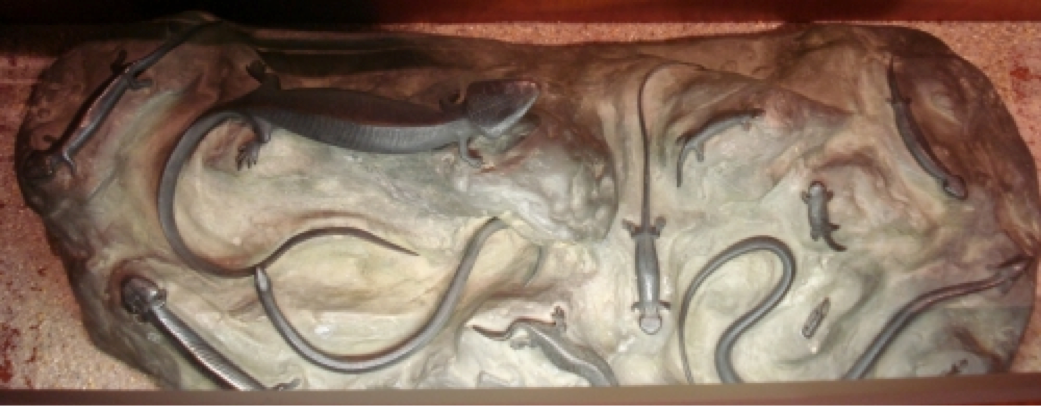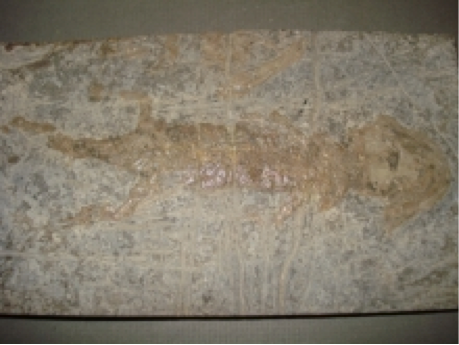354-286 million years ago
Highlights of the Carboniferous
- Was a time of glaciations and low sea level
- Many coal beds were laid down at this time
- Time of active mountain building
Rhipdistian fishes gave way to amphibians about 350 million years ago. Amphibians were the first backboned animals with limbs designated for use on land. Like their descendants, frogs and newts, early amphibians had to lay their shell-less eggs in water to prevent them from drying up. The eggs hatched into tadpoles which breathed through gills that later usually shrank. Some adults grew as big as a crocodile. Early amphibians lived mainly in or near fresh water, hunting fishes, insects, or reptiles. They dominated swamps that covered much of coastal North America and Europe in Late Carboniferous (Pennsylvanian) and early Permian times. Early species of amphibians gave rise to reptiles and so, indirectly to all other backboned land animals.
On display at the University of Waterloo
12 Late Carboniferous Amphibians - Model

The original plaster models were made by Professor Antonius Fritsch at the National Museum, Prague, Czechoslovakia in 1886. This bronze casting was prepared for display in the Czechoslovakian pavilion at the Exposition Universelle held in 1887 in Paris.
This bronze model was one of more than 30,000 exhibits at the Exposition Universelle. The most well known exhibit at the Exposition was the Eiffel Tower, which was fabricated as a temporary exhibit!
The plaster model image gallery
Discosauriscus Austriacus

Order: Sauropterygia
Length: roughly 20cm
When did I live? Permian, 285 million years ago
Where? Letovice, Czech Republic
What family did I belong to? Discosaurus austriacus
What food did I eat? Unclear
What special feature did I have? I had a wide jaw, with sharp teeth, short limbs and a long tail
Pennsylvanian Sub-Period
320 - 286 Million Years Ago
Highlights of the Pennsylvanian
- Wide spread swamps
- Many coal beds were laid down at this time
- The first reptiles evolved. They were small (about a foot long) and outnumbered by the amphibians
- Many insects
During the Pennsylvanian period (286-320 million years ago), extensive forests grew in swamps on river deltas. The coal swamps of eastern North America occupied a basin bordered on the south and east by the Appalachian Highlands and on the north by the low swell of the Canadian Shield. Trees over 30 metres high grew on a mush of organic material. In death they made their own contribution to the peaty layer.
Bacterial decay was limited by a lack of oxygen, allowing delicate fossil leaves to be preserved. As the area cycled from swamp to a shallow marine environment, the organic material was covered by layers of sediment. Sand formed sandstone, mud formed shale and siltstone, marine creatures with calcium carbonate skeletons formed limestone. The swamp deposit sank deep under the weight and the water was squeezed out. Ten meters of wet, porous material was converted to one meter of coal.